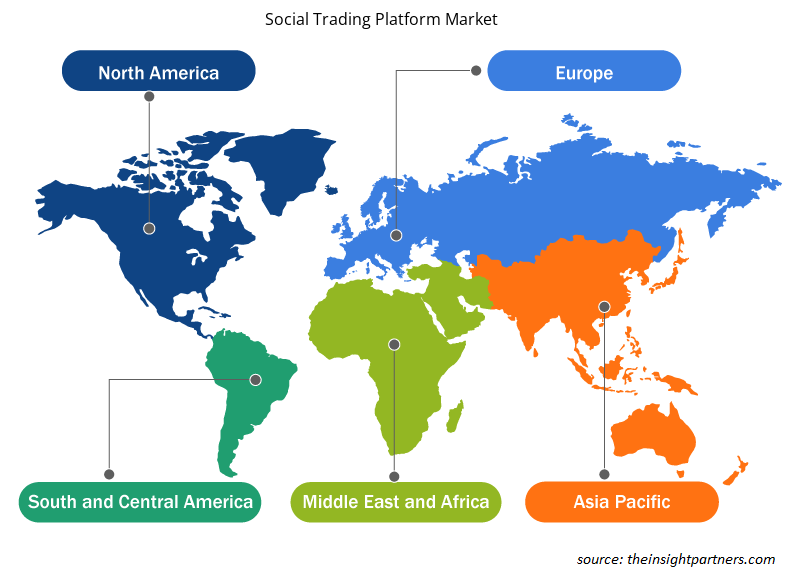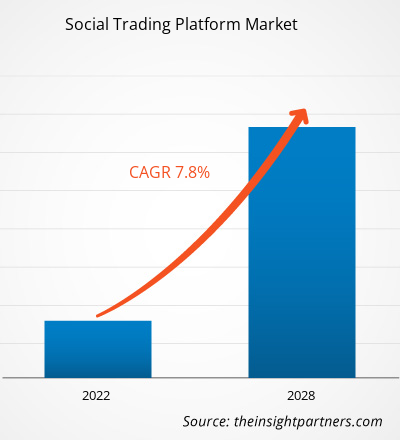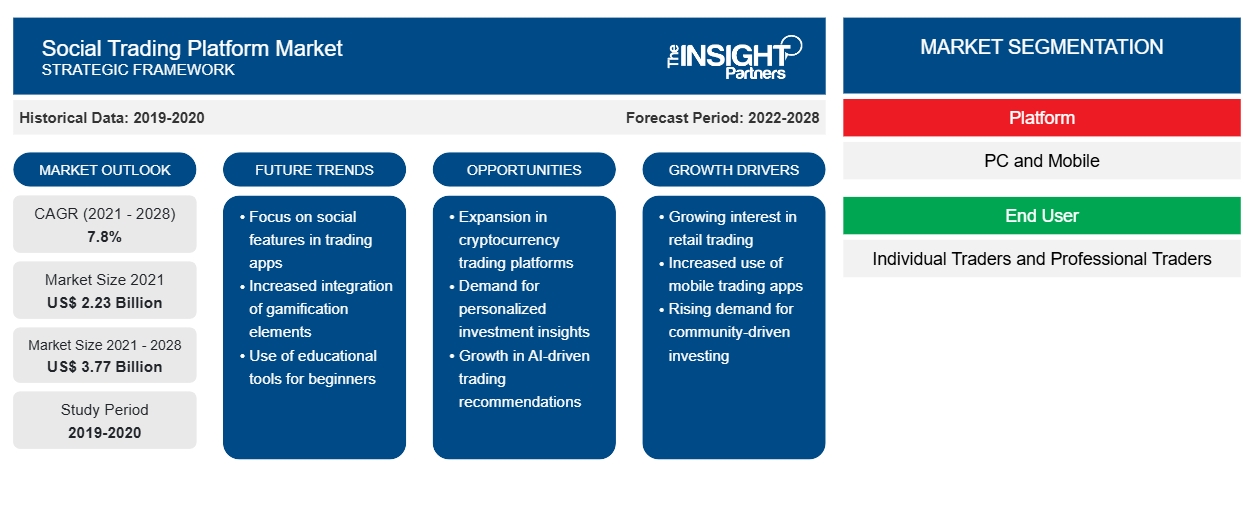Se espera que el mercado de plataformas de comercio social crezca de US$ 2.229,56 millones en 2021 a US$ 3.774,17 millones en 2028; se estima que aumentará a una CAGR del 7,8% entre 2021 y 2028.
El software de plataforma de negociación personalizado aumenta de manera efectiva los ingresos de las organizaciones y brinda una mejor satisfacción del cliente. Los comerciantes adoptan ampliamente una plataforma de negociación personalizada por su facilidad de uso. La plataforma de negociación personalizada proporciona a los clientes gráficos detallados y fáciles de leer, estadísticas en tiempo real y sistemas de informes personalizados. Por ejemplo, en mayo de 2021, ParagonEX (líder en tecnología financiera) lanzó una plataforma de negociación totalmente personalizable, lo que permite a sus clientes corredores decidir cada detalle de la apariencia de las plataformas. La personalización incluye todos los elementos de la plataforma de negociación, lo que permite una personalización infinita por corredor o usuario final. La nueva plataforma permite que cada corredor tenga una apariencia única, mostrando elementos de su elección, creando así una identidad de marca distintiva y atendiendo al perfil y la combinación de sus usuarios finales.
El software también proporciona un análisis de gráficos avanzado y detallado según las necesidades de los clientes. Con este análisis de gráficos, la lectura y la comprensión de los datos dados son cruciales en la industria del trading. El análisis de gráficos avanzado ofrece a los usuarios algunas funciones flexibles y personalizadas que permiten la preparación de gráficos según las necesidades de los usuarios. Aparte de los beneficios anteriores, una plataforma de trading personalizada también ofrece varias opciones para leer y comprender las tendencias de la industria, predecir las fluctuaciones de precios, crear gráficos personalizados y personalizados y administrar múltiples cuentas desde una única plataforma de trading social. Por lo tanto, debido a todos estos beneficios, contribuye al crecimiento del mercado de plataformas de trading social a nivel mundial.
Personalice este informe según sus necesidades
Obtendrá personalización en cualquier informe, sin cargo, incluidas partes de este informe o análisis a nivel de país, paquete de datos de Excel, así como también grandes ofertas y descuentos para empresas emergentes y universidades.
-
Obtenga las principales tendencias clave del mercado de este informe.Esta muestra GRATUITA incluirá análisis de datos, desde tendencias del mercado hasta estimaciones y pronósticos.
Impacto de la pandemia de COVID-19 en el mercado global de plataformas de comercio social
Las plataformas de comercio social prevalecieron durante la transformación digital de las instituciones financieras y las soluciones y servicios bancarios. Según el artículo publicado por Business Wire, el gasto en transformación digital fue de 1,18 billones de dólares en 2019, un aumento del 17,9 % con respecto a 2018, y la necesidad de transformación digital respaldó el crecimiento del mercado de plataformas de comercio social.
Además, en 2021 y 2022, la relajación de las medidas de confinamiento y el aumento de las tasas de empleo influyeron positivamente en el crecimiento del mercado de plataformas de comercio social. El aumento de la tendencia de inversión en criptomonedas influyó positivamente en el crecimiento del mercado. Según el Free Press Journal, Bitcoin experimentó un auge y sorprendió al mundo entero, pasando de aproximadamente 7.000 dólares estadounidenses en marzo de 2020 a más de 54.000 dólares estadounidenses hasta junio de 2021.
Perspectivas del mercado de plataformas de comercio social
Beneficios crecientes de la integración de chatbots con plataformas comerciales
La industria del comercio en línea está aumentando significativamente con la evolución de las tecnologías avanzadas. Debido a la pandemia de COVID-19, el patrón de comercio en línea se fortaleció en 2020. Según el artículo publicado por Chatbots Life, también se ha observado que más de 2.14 mil millones de personas en todo el mundo compraron bienes y servicios en línea en 2021, lo que resultó en la rápida evolución de la industria del comercio en línea a nivel mundial. Debido a la rápida evolución de la industria del comercio en línea, el desafío para los comerciantes de mantenerse al día con el ritmo del cambio para mantenerse actualizados y procesar todas las tareas también está aumentando en paralelo. Por lo tanto, la integración de chatbots basados en IA es esencial para que las organizaciones comerciales mejoren la experiencia y la productividad del cliente.
Los chatbots cumplen la función de corredores personales al ayudar a los comerciantes con tareas y operaciones. Realizan investigaciones más profundas, obtienen información sobre los compradores, sus necesidades, problemas y expectativas, y brindan soporte las 24 horas del día, los 7 días de la semana y responden a las consultas. Ayudan a los usuarios a mantenerse actualizados con las últimas tendencias del mercado que pueden mejorar el progreso de la empresa. Además, la integración de bots financieros en el sistema permite a los usuarios automatizar el proceso de negociación para que se ejecute en segundo plano las 24 horas del día, los 7 días de la semana, sin interrupciones. La solución ayuda a los usuarios a mantenerse al tanto de las tendencias del mercado y realizar las operaciones correctas en el momento adecuado.
Además, la integración de chatbots en las plataformas de trading online de los usuarios ayuda a procesar y analizar la enorme cantidad de datos y a realizar cálculos matemáticos de manera eficaz. Además, los chatbots de trading son una excelente herramienta de aprendizaje, especialmente para los traders novatos. Por lo tanto, contar con múltiples beneficios de los chatbots en el trading online ayuda a las organizaciones a mantenerse competitivas y a mejorar las posibilidades de éxito a largo plazo. Por lo tanto, la demanda de chatbots está aumentando en las plataformas de trading social.
Información del mercado basada en plataformas
Según la plataforma, el mercado de plataformas de comercio social se divide en PC y dispositivos móviles. En 2021, el segmento móvil lideró el mercado de plataformas de comercio social y representó la mayor participación en el mercado.
Información del mercado basada en el usuario final
Según el usuario final, el mercado de plataformas de comercio social se puede dividir en comerciantes individuales y comerciantes profesionales. En 2021, el segmento de comerciantes individuales representó la mayor participación de mercado.
Perspectivas regionales del mercado de plataformas de comercio social
Los analistas de Insight Partners explicaron en detalle las tendencias y los factores regionales que influyen en el mercado de plataformas de comercio social durante el período de pronóstico. Esta sección también analiza los segmentos y la geografía del mercado de plataformas de comercio social en América del Norte, Europa, Asia Pacífico, Oriente Medio y África, y América del Sur y Central.

- Obtenga datos regionales específicos para el mercado de plataformas de comercio social
Alcance del informe de mercado de plataformas de comercio social
| Atributo del informe | Detalles |
|---|---|
| Tamaño del mercado en 2021 | US$ 2,23 mil millones |
| Tamaño del mercado en 2028 | US$ 3,77 mil millones |
| CAGR global (2021-2028) | 7,8% |
| Datos históricos | 2019-2020 |
| Período de pronóstico | 2022-2028 |
| Segmentos cubiertos |
Por plataforma
|
| Regiones y países cubiertos |
América del norte
|
| Líderes del mercado y perfiles de empresas clave |
|
Densidad de actores del mercado de plataformas de comercio social: comprensión de su impacto en la dinámica empresarial
El mercado de plataformas de comercio social está creciendo rápidamente, impulsado por la creciente demanda de los usuarios finales debido a factores como la evolución de las preferencias de los consumidores, los avances tecnológicos y una mayor conciencia de los beneficios del producto. A medida que aumenta la demanda, las empresas amplían sus ofertas, innovan para satisfacer las necesidades de los consumidores y aprovechan las tendencias emergentes, lo que impulsa aún más el crecimiento del mercado.
La densidad de actores del mercado se refiere a la distribución de las empresas o firmas que operan dentro de un mercado o industria en particular. Indica cuántos competidores (actores del mercado) están presentes en un espacio de mercado determinado en relación con su tamaño o valor total de mercado.
Las principales empresas que operan en el mercado de plataformas de comercio social son:
- eToro
- A-Comercio
- Comercio Zulu
- Tornado
- MetaCitas
Descargo de responsabilidad : Las empresas enumeradas anteriormente no están clasificadas en ningún orden particular.

- Obtenga una descripción general de los principales actores clave del mercado de plataformas de comercio social
Perspectivas del mercado basadas en clases de activos
Según la clase de activo, el mercado de plataformas de comercio social se puede segmentar en acciones, materias primas, derivados, criptomonedas y otros. En 2021, el segmento de criptomonedas representó la mayor participación en el mercado global de plataformas de comercio social.
Los actores que operan en el mercado de plataformas de comercio social han estado adoptando diversas estrategias, como fusiones y adquisiciones, para mantener sus posiciones en el mercado de plataformas de comercio social. A continuación, se enumeran algunos avances de los actores clave:
- En enero de 2022, eToro amplió su oferta de inversión en EE. UU. para incluir acciones estadounidenses y ETF (fondos cotizados en bolsa).
- En diciembre de 2021, eToro anunció el lanzamiento de su programa eToro Money para consumidores del Reino Unido. eToro Money se integra con la cuenta de inversión eToro del usuario, lo que le permite depositar y retirar efectivo instantáneamente y administrar sus criptomonedas y finanzas en un solo lugar.
Perfiles de empresas
- eToro
- A-Comercio
- Comercio Zulu
- Tornado
- MetaCitas
- PrimeXBT
- Mercados Pepperstone Limitada
- Molino de garrapatas
- Octa Markets Incorporated
- Assetgro Fintech Pvt. Ltd. (Stockgro)
- Holding público, inc.
- Grupo Naga AG
- Bola de nieve X
- Análisis histórico (2 años), año base, pronóstico (7 años) con CAGR
- Análisis PEST y FODA
- Tamaño del mercado, valor/volumen: global, regional y nacional
- Industria y panorama competitivo
- Conjunto de datos de Excel
Testimonios
Razón para comprar
- Toma de decisiones informada
- Comprensión de la dinámica del mercado
- Análisis competitivo
- Información sobre clientes
- Pronósticos del mercado
- Mitigación de riesgos
- Planificación estratégica
- Justificación de la inversión
- Identificación de mercados emergentes
- Mejora de las estrategias de marketing
- Impulso de la eficiencia operativa
- Alineación con las tendencias regulatorias























 Obtenga una muestra gratuita para - Mercado de plataformas de trading social
Obtenga una muestra gratuita para - Mercado de plataformas de trading social